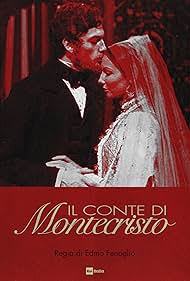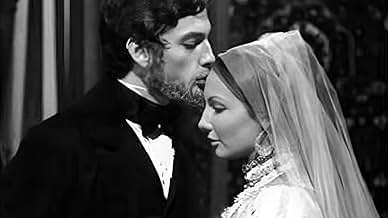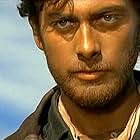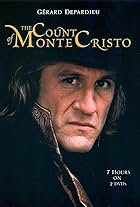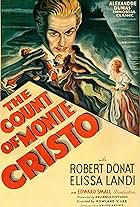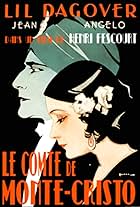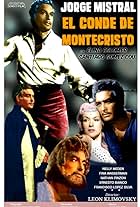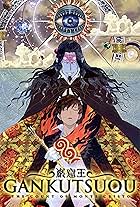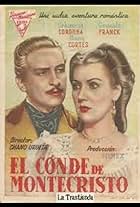Aggiungi una trama nella tua linguaImprisoned on a trumped-up charge by enemies he cannot identify, Edmond Dantes vows revenge - which takes him twenty-five years to achieve.Imprisoned on a trumped-up charge by enemies he cannot identify, Edmond Dantes vows revenge - which takes him twenty-five years to achieve.Imprisoned on a trumped-up charge by enemies he cannot identify, Edmond Dantes vows revenge - which takes him twenty-five years to achieve.
Sfoglia gli episodi
Trama
Lo sapevi?
- ConnessioniVersion of The Count of Monte Cristo (1908)
Recensione in evidenza
Watching "Il Conte di Montecristo" have been impressed by the very faithful adaptation of the work of Dumas, valuable feuilleton published in serial form in the Journal des Debats between 1844 and 1846, with a screenplay by Edmo Fenoglio, also Director, and Fabio Storelli, able to prune when needed to bring out the best and with a rare effectiveness the main themes of the novel, by viewing them with suggestive gradually, envy and human pettiness towards his fellow men, the desire for revenge that turns gradually into a sort of omnipotence superman. Edmond Dantès thinks to replace God in equally distribute justice, forgiveness and mercy, then come to terms with himself, with his own past and haunted memories of a love interrupted but not dormant, giving that happiness which failed and perhaps never will never enjoy, opening the doors to hope anyway.
I was also fascinated by the accurate staging, a theatrical film in one breath but certainly impact strongly dilution of various events, albeit with a slowness in the proposition that dumbfounding compared to today's rhythms, not just television, but fascinating for how the actors manage to hold the first and earliest plans, a characteristic of Fenoglio, with an emphatic ever acting or over the top careful, measured, from Andrea Giordana, almost debutant, at ease as much as Dantès than in those of the count of Monte Cristo, as well as in various disguises, emphasizing pains and torments of mind, divine fury and earthly troubles.
But the whole cast, mostly from theatrical experience, is capable of great interpretations and characterizations, from Mercedes to Giuliana Lojodice, Fernando Alberto Terrani Mondego, through Achille Millo (Danglars), Quinto Parmeggiani (Caderousse) and Enzo Tarascio (Villefort), not to mention Sergio Tofano, unforgettable Abbe Faria, Luigi Pavese (Morrel) or the brief appearance by Mario Scaccia in the role of Louis XVIII.
I'd like to mention the costumes by Danilo Donati, music by Gino Marinuzzi jr., Lasoi scenes and photography by Mario Bernardo all contribute in short to make this drama, even in consideration of the time of accomplishment, something unique and certainly memorable as a whole, I recommend the vision of this old TV movie, especially to the younger ones that may notice the palpable difference, for the better, with what currently passes the monastery without the necessary exceptions, of course.
I was also fascinated by the accurate staging, a theatrical film in one breath but certainly impact strongly dilution of various events, albeit with a slowness in the proposition that dumbfounding compared to today's rhythms, not just television, but fascinating for how the actors manage to hold the first and earliest plans, a characteristic of Fenoglio, with an emphatic ever acting or over the top careful, measured, from Andrea Giordana, almost debutant, at ease as much as Dantès than in those of the count of Monte Cristo, as well as in various disguises, emphasizing pains and torments of mind, divine fury and earthly troubles.
But the whole cast, mostly from theatrical experience, is capable of great interpretations and characterizations, from Mercedes to Giuliana Lojodice, Fernando Alberto Terrani Mondego, through Achille Millo (Danglars), Quinto Parmeggiani (Caderousse) and Enzo Tarascio (Villefort), not to mention Sergio Tofano, unforgettable Abbe Faria, Luigi Pavese (Morrel) or the brief appearance by Mario Scaccia in the role of Louis XVIII.
I'd like to mention the costumes by Danilo Donati, music by Gino Marinuzzi jr., Lasoi scenes and photography by Mario Bernardo all contribute in short to make this drama, even in consideration of the time of accomplishment, something unique and certainly memorable as a whole, I recommend the vision of this old TV movie, especially to the younger ones that may notice the palpable difference, for the better, with what currently passes the monastery without the necessary exceptions, of course.
- mario-alvisi
- 28 nov 2015
- Permalink
I più visti
Accedi per valutare e creare un elenco di titoli salvati per ottenere consigli personalizzati
Dettagli
- Data di uscita
- Paese di origine
- Sito ufficiale
- Lingua
- Celebre anche come
- The Count of Monte Cristo
- Azienda produttrice
- Vedi altri crediti dell’azienda su IMDbPro
- Tempo di esecuzione8 ore
- Colore
- Mix di suoni
- Proporzioni
- 1.33 : 1
Contribuisci a questa pagina
Suggerisci una modifica o aggiungi i contenuti mancanti

Divario superiore
By what name was Il conte di Montecristo (1966) officially released in Canada in English?
Rispondi